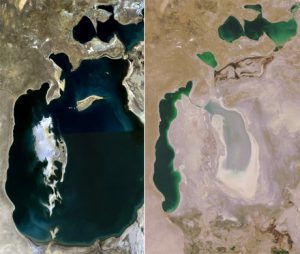It’s been a brutal summer for much of urban China. From the once-in-60-years storm that lashed Beijing in July, killing 79 people and costing US$1.6 million, to the typhoon floods that triggered mass evacuations in Jingdezhen city, the heavens have been parading their power.
Along with heavy rains, the season has brought a raft of new warnings about the perils facing China’s cities. A World Bank report put China “among the most vulnerable countries exposed to meteorological hazards” and called for urgent action to prepare for disasters. Research from a team of British and Dutch scientists claimed Shanghai was the most susceptible to severe flooding of nine major global cities. And, in a special report on Asian urbanisation, published in August, the Asia Development Bank (ADB) urged the continent’s rapidly growing metropolises to go green or “face a bleak and environmentally degraded future”.
There are good reasons for all the noise. Asia’s cities are growing at a pace faster than anything the world has ever seen. In a little over a decade, the continent will have 21 of the planet’s 37 megacities, if ADB forecasts are accurate. And China is leading the pack. It already has 665 million urban residents; another 350 million are expected to join them in the next 20 years. Every 12 months, says the World Bank, the equivalent of a new megacity – a Shanghai or Beijing – will be created in China.
“What happens in the cities affects overall growth and what happens with overall growth affects the opportunities in the cities, which helps to attract new migrants, which keeps the process snowballing,” said Doug Brooks, ADB assistant chief economist, who led the organisation’s research. “I don’t think it’s too surprising, but it does have strong implications.”
Big among those implications is heightened exposure to natural disaster as people, wealth and creativity not only concentrate, but concentrate in places increasingly vulnerable to climate-change impacts. Already, the dense urban belt that stretches down China’s east-coast is grappling with major threats: of the 40 Asian cities most vulnerable to coastal flooding, half are in China, according to ADB. Future sea-level rise will only exacerbate the risks.
There’s a host of other dangers too: saltwater intrusion into freshwater supplies, subsidence and shifting weather patterns – the Intergovernmental Panel on Climate Change predicts typhoons will become more violent as the surface temperature of the ocean rises. They can be brutal already: Typhoon Talim, for example, killed 110 people in eastern China in 2005.
As well as density, the sheer speed of China’s urbanisation brings its own challenges, as cities struggle to respond to rocketing pressure on infrastructure and services, said Brooks. The less well they do, the more vulnerable populations will be. But the better they perform, the more people will come. “The biggest challenge is people move into the cities and they don’t have good quality living conditions, public services, infrastructure, those sorts of things. But if the government provides them, that just winds up attracting more people. So there’s a trade-off between what the government can provide and what sort of results it will get if it does provide,” said Brooks.
This juggling act can make reliable growth estimates hard to come by. Past experience shows China’s city forecasts can be wide of the mark. When the sleepy fishing village of Shenzhen was made a Special Economic Zone in 1980, city officials put the target population at 300,000. By 2010, the city had more than 10 million. Its appeal to migrants ended up far outstripping anything policymakers had predicted.
So should the government be seeking to cap growth in some way? No, said Brooks. When it comes to the size and speed, direct intervention can do more harm than good, and exacerbate existing inequalities. “The problem with trying to control it is you wind up benefitting the people who have already done it and hurting the people who are trying to do it. My own feeling is it’s better to let people make their own choices, but you can influence they type of incentives they face to do that.”
One of the things ADB would like to see incentivised is development of smaller satellite cities around the central megacity core, so as to spread people out and relieve pressure on the centre. The key, said Brooks, is providing good public transport, which can “help people move to the central city when they need to but move out of it when they don’t need to”. At the same time, governments need to invest in climate-proofing: constructing houses in safe areas, prioritising drainage infrastructure and putting in place the best climate forecast technology.
It sounds like decent advice, but some are sceptical about the likelihood of China taking the necessary action to de-risk its cities. Cleo Paskal is associate fellow at London-based think-tank Chatham House and author of Global Warring: How Environmental, Economic and Political Crises will Redraw the World Map. She points to enduring corruption, poor transparency and a “King Cnut” emphasis on heavy engineering as an environmental fix-all as reasons to be worried.
The last of these is fleshed out by the multibillion dollar South-North water transfer project to channel water to arid parts of China, she said. “So you’ve got an unstable coast and you’re cutting a canal just behind that unstable coast. That increases your likelihood of saltwater infiltration into freshwater systems, especially if sea-levels rise. But if your job as an engineer is to devise the channel and someone else’s job is the coast, unless you’re working together and sharing data, you can end up with pretty big mistakes.”
Shanghai not ready for natural disaster
More recently in Shanghai, a row has erupted over the extent of the city’s vulnerability. In August, city officials acted quickly to dismiss research published in Natural Hazards journal, which put Shanghai at the top of a flood-vulnerability ranking, above Dhaka in Bangladesh and Manila in the Philippines. Hu Xin, deputy director of the Shanghai Flood Control Headquarters, said the findings were “incomplete”, according to China Daily. He pointed out that the city’s coastal levees were designed to withstand a once-in-200-year high tide. Researchers from Fudan University have also pitched in with historical data showing the city has rarely been struck by typhoons.
But for Paskal, this is a sign China is not prepared to admit that its richest – and perhaps most prestigious – mainland city, home to glittering skyscrapers and the Maglev bullet train, is at risk of catastrophe as climate change rewrites the rules of the game. It is “very hard to imagine” that a disaster on the scale of Hurricane Katrina won’t happen at some point here, she said, pointing out that Shanghai shares many similarities with New Orleans: aside from rising sea-levels, both cities sit in typhoon pathways and on sinking river deltas – Shanghai has dropped by more than 1.8 metres since 1921. Meanwhile, chemical plants strung along the coast and interspersed with high-rise apartment blocks – built thanks to malleable zoning laws and pally relations between local officials and developers – mean a “Fukushima-type” scenario could also be on the cards, she said.
“If China wants true stable development that will show real security to its population it needs to be honest about what areas are going to stable and what areas aren’t. They can’t continue to band-aid a place like Shanghai, because it will get hit and when it gets hit the implications are humanitarian but they’re also economic and political.”
Olivia Boyd is managing editor at chinadialogue.
Homepage image by Greenpeace




